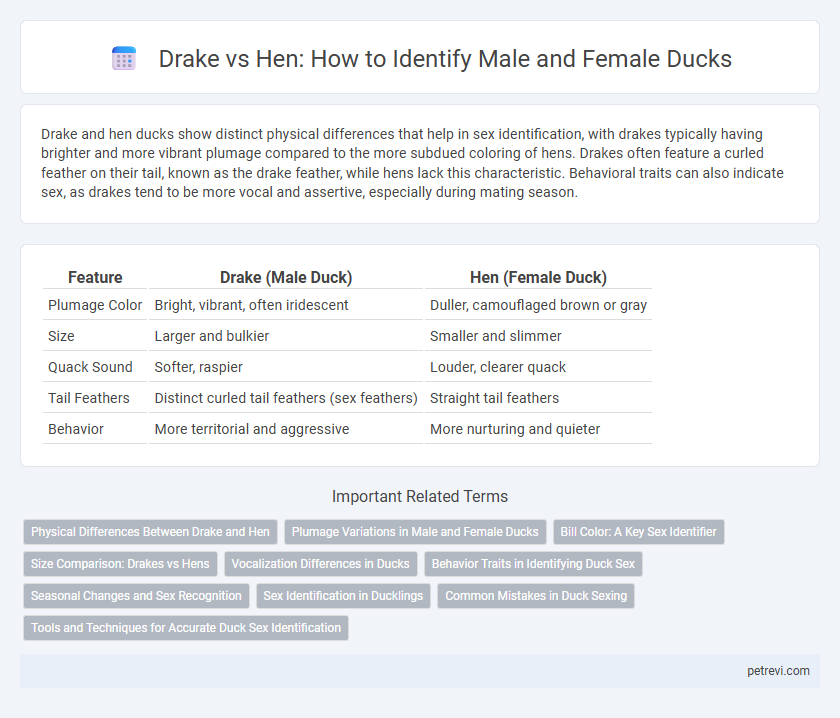Drake and hen ducks show distinct physical differences that help in sex identification, with drakes typically having brighter and more vibrant plumage compared to the more subdued coloring of hens. Drakes often feature a curled feather on their tail, known as the drake feather, while hens lack this characteristic. Behavioral traits can also indicate sex, as drakes tend to be more vocal and assertive, especially during mating season.
Table of Comparison
| Feature | Drake (Male Duck) | Hen (Female Duck) |
|---|---|---|
| Plumage Color | Bright, vibrant, often iridescent | Duller, camouflaged brown or gray |
| Size | Larger and bulkier | Smaller and slimmer |
| Quack Sound | Softer, raspier | Louder, clearer quack |
| Tail Feathers | Distinct curled tail feathers (sex feathers) | Straight tail feathers |
| Behavior | More territorial and aggressive | More nurturing and quieter |
Physical Differences Between Drake and Hen
Drakes typically exhibit more vibrant plumage with iridescent green heads, while hens display mottled brown feathers for better camouflage. Drakes have thicker, more robust bodies and a distinctive curled feather on their tail called the drake feather. In contrast, hens possess leaner frames with straight tail feathers, making tail shape and color the primary physical markers for sex identification.
Plumage Variations in Male and Female Ducks
Drakes typically exhibit bright, iridescent plumage with distinct color patterns such as the glossy green head of a mallard, while hens display more muted, camouflaged feathers in brown or gray tones to enhance nest protection. Male ducks' feathers often possess a sheen and intricate markings that are absent in females, serving both in mating displays and territorial behavior. Female plumage variations prioritize concealment and are less vibrant, aiding in their role during incubation and rearing of ducklings.
Bill Color: A Key Sex Identifier
Bill color serves as a crucial sex identifier in ducks, with drakes typically displaying brighter, more vibrant hues such as yellow or green, while hens usually possess duller, more muted shades like brown or olive. This color differentiation aids in distinguishing males from females in many duck species during breeding seasons. Observing the bill color alongside other physical traits enhances accurate sex identification in ducks.
Size Comparison: Drakes vs Hens
Drakes are generally larger than hens, exhibiting a more robust body size with broader chest and longer necks. This size difference is a key indicator in sex identification, as hens tend to have a smaller, more compact frame. Weight variations also support identification, with drakes often surpassing hens by 10-20% in mass.
Vocalization Differences in Ducks
Drakes produce a quieter, raspier quack compared to hens, whose vocalizations are louder and more resonant. The male's calls tend to be softer and more varied, serving as mating signals, while female ducks use louder quacks for communication and alerting. These vocalization differences provide a reliable method for distinguishing between drakes and hens in duck sex identification.
Behavior Traits in Identifying Duck Sex
Drake ducks exhibit more aggressive and territorial behavior compared to hens, often vocalizing with a quieter whistle while hens produce a louder quack. Observing courtship displays such as head bobbing and wing flapping can help distinguish drakes, as these behaviors are less common in hens. Additionally, drakes tend to be more active and dominant in social interactions within the flock.
Seasonal Changes and Sex Recognition
Duck sex identification hinges on distinguishing drakes (males) from hens (females) through physical traits that shift with seasonal changes. During breeding season, drakes exhibit vibrant plumage and a distinctive curled tail feather, while hens maintain muted colors for camouflage. Recognizing these seasonal markers aids accurate sex determination essential for breeding management and ecological studies.
Sex Identification in Ducklings
Sex identification in ducklings is crucial for breeding and management, relying on physical and behavioral differences between drakes (males) and hens (females). Drakes typically have a curled tail feather called a drake feather and exhibit louder quacking, while hens produce softer quacks. Visual markers such as the color of the plumage, size, and the presence of a white ring around the neck in some breeds help distinguish drakes from hens during early life stages.
Common Mistakes in Duck Sexing
Common mistakes in duck sex identification often arise from confusing the male drake's curled tail feathers with similar features in hens, leading to inaccurate sexing. Many beginners misinterpret vocal differences, as some hens can produce sounds resembling drake calls, complicating auditory sex determination. Reliance on feather coloration alone may also result in errors, especially in juvenile ducks where plumage is not fully developed.
Tools and Techniques for Accurate Duck Sex Identification
Accurate duck sex identification relies on tools such as cloacal examination, DNA testing, and feather sexing techniques to distinguish between drakes and hens. Cloacal examination, performed by experienced handlers, is the most direct and reliable method, while feather sexing assesses wing plume patterns and coloration unique to each sex. DNA sexing offers precise results through genetic analysis, especially useful for young or similar-looking ducks where visual cues are inconclusive.
Drake vs Hen for Duck sex identification Infographic

 petrevi.com
petrevi.com